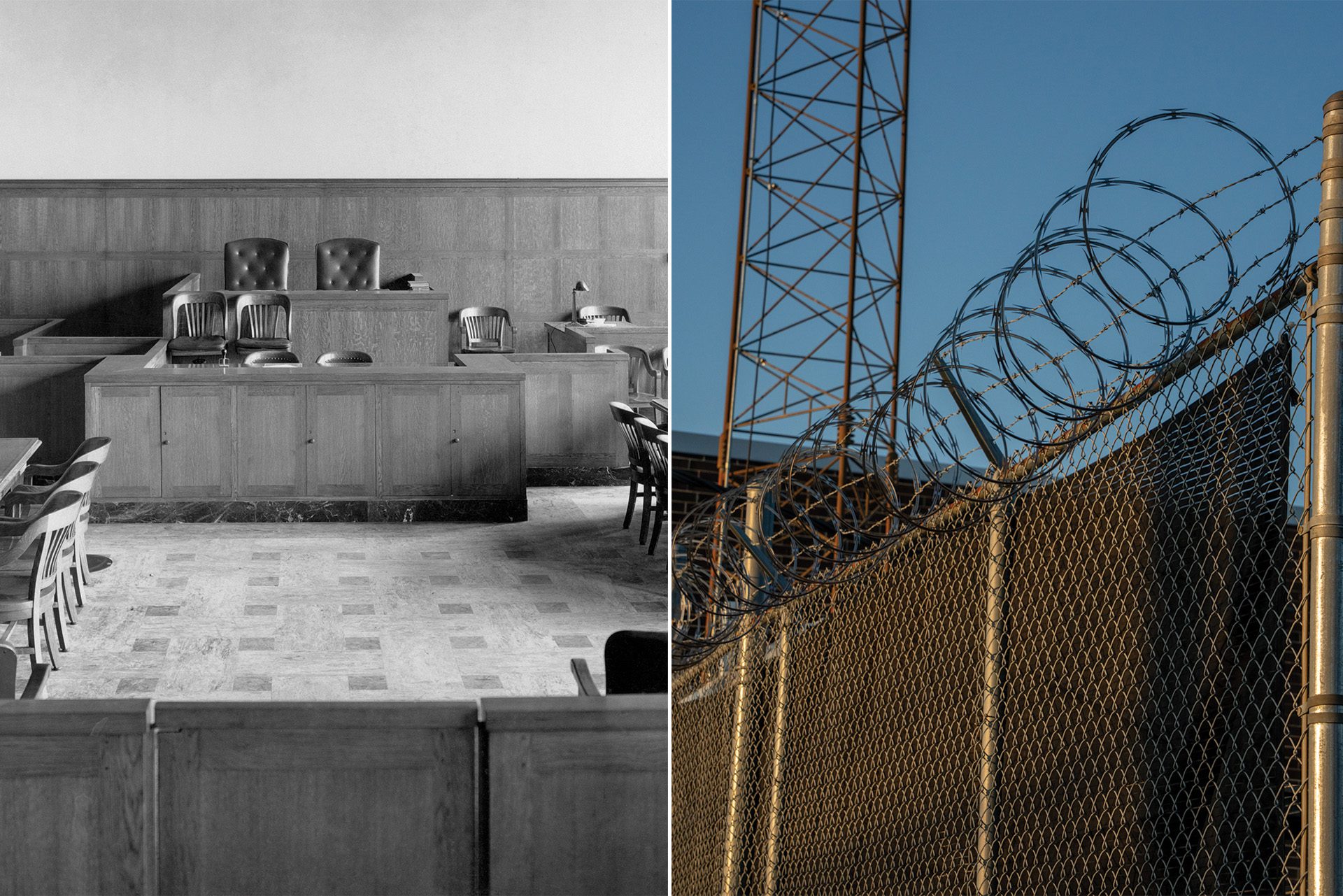 First image: Underwood Archives, Inc / Alamy Stock Photo. Second photo: Camilla Forte/Borderless Magazine/Catchlight Local/Report for America
First image: Underwood Archives, Inc / Alamy Stock Photo. Second photo: Camilla Forte/Borderless Magazine/Catchlight Local/Report for America The Department of Homeland Security has removed the right to immigration court bonds, leaving immigrants in detention — and their cases in limbo — for months or even years.
Claudia and Edgar heard a knock at the front door of their home in Illinois around 11 a.m. in late June.
With their one-year-old child in hand, the couple, who are being identified by pseudonyms for safety concerns, answered the door to several men who identified themselves as agents with Immigration and Customs Enforcement (ICE). The agents — some masked — demanded to see the identification of Edgar’s 18-year-old son, who was pursuing a Special Immigrant Juvenile status classification.
Edgar went to get his son and identification, but when he returned, the ICE agent switched his focus to Edgar and his immigration status. After a few minutes of back-and-forth, Edgar handed his crying baby to his wife, and he was handcuffed and taken away.
¿Quieres recibir historias como esta en tu correo cada semana?
Suscríbase a nuestro boletín gratuito.

Now, more than two months after his arrest, Edgar remains detained despite a judge granting him bond on July 18. Because of a new interpretation of a nearly 30-year-old law, Edgar is being forced to stay in a Kentucky detention center as his appeal passes through the courts, leaving his family unsure of when they’ll see him again.
Edgar is among thousands of immigrants in limbo as the Trump administration denies bond hearings and expands immigration agents’ discretion to detain noncitizens who have lived in the U.S. for decades. Some detainees have children who are U.S. citizens, which may offer them legal pathways to remain in the country.
In July, the Department of Homeland Security (DHS) sent a memo directing trial attorneys to oppose bond grants for individuals who entered the U.S. without inspection (EWI). President Donald Trump and DHS’ new interpretation of the 1996 Immigration and Nationality Act was due to the department revisiting “its legal position on detention and release authorities,” according to the memo.
Previously, immigrants who had entered without inspection and had no criminal bars were eligible for bond if detained. In immigration court, a bond is an amount of money paid to the U.S. government to guarantee that a detained non-citizen will attend their required immigration hearings and comply with court orders, including deportation orders, in exchange for their temporary release.
However, this new directive from Trump and DHS removes that right in nearly all cases, including for those seeking asylum and those who have lived in the U.S. for many years and have children and grandchildren who are citizens.
Earlier this month, an immigration appeals court ruled detention is mandatory for anyone in deportation proceedings who entered the U.S. “without inspection.”
The new practice, attorneys say, will lead to the detention of millions of individuals for months and possibly years.
Lisa Chun, a managing attorney at the National Immigrant Justice Center, says that DHS is now considering all immigrants to be new admissions to the country, even if they’ve been here for decades.
“They are stretching [this law] to the point of absurdity,” she said.
‘Likely to be litigated’
Under the Trump administration, immigration courts have seen a whirlwind of changes, from encouraging ICE to carry out arrests at the courts to expanding the extent of expedited removal from recent arrivals and those seized near the U.S. border to those who have lived in the U.S. for less than two years.
Immigrants’ ability to obtain a bond has been a long-time target of conservative groups who say it allows long-term stays for immigrants and helps them avoid court hearings.
The Department of Justice did not respond to questions from Borderless Magazine.
Attorneys say the bond policy change intends to encourage voluntary departure, especially among immigrants who otherwise would have strong cases.
Even in events where a judge agrees that bond should be allowed, such as in Edgar’s case, this new interpretation effectively allows DHS trial attorneys to disregard a judge’s authority.
Within the memo, Todd M. Lyons, acting director of ICE, acknowledged that this move is “likely to be litigated.”
Chun isn’t surprised.
“Their calculation is not, ‘is this legal?’ Their calculation is, ‘how do we impose maximum harm for as long as we can, even though we probably know we’re going to lose?’” Chun said.
Katherine Hawkins, senior legal analyst at the Project on Government Oversight, described the memo as a novel interpretation of the law that doesn’t allow for the typical legal challenge.
“The immigration court system is a weird system: I’ve called it ‘Due Process Lite’ or ‘Dollar Store Due Process,’” Hawkins said. “There aren’t rules of evidence, there is no right to an attorney…it’s not an independent court system to begin with, but what independence there was, the administration is trying hard to eliminate, and has gotten pretty far with it already. This memo is another part of that.”
Hawkins adds another alarming layer to what’s occurring across the country: government authorities are using hype videos and propaganda as scare tactics.
“There is an effort to scare people out of coming, and scare people into just giving up and not fighting the deportation, because that’s the only way that you can get to the mass deportation numbers that Trump and [Stephen] Miller want. They are trying to skip that in every way possible.”
As detentions increase, so do immigration court backlogs
Más de 60,000 immigrants are being held in detention — nearly double the amount recorded this time last year. A data research group Transaction Records Access Clearinghouse analyzed ICE facility data in April and found the national contractual capacity was 62,913 beds. As detentions increase, many reports have emerged of immigrants sleeping on floors and not receiving meals due to overcrowded facilities.
Simultaneously, the backlog of court cases continues to grow, with current numbers nearing 3.5 million, and immigration judges across the nation are being fired, often without explanation.
In recent months, attorneys like Chun have described disturbing conditions at detention facilities. Chun’s clients described improper medical care for new and existing conditions, a lack of interpretation services, no mental health resources and substandard nutrition, especially for clients with health concerns that require specific diets.
Claudia said Edgar’s experience in detention has been similar. Her voice broke as she recalled a conversation with him on one of their first phone calls. “To put it into perspective, our one-year-old son would eat more than the food that they give him at the detention center.”
In addition to these poor conditions, the chaos surrounding the immigration process continues to mount.
Una common tactic of ICE has been to send immigrants to detention centers far away from their families in remote detention facilities in Louisiana or Texas, states with more detention locations and where the immigration courts are far stricter.
In Illinois, where detention facilities have been banned since 2021, immigrants are often held in county jails. These facilities are typically reserved for overnight or short-term holds, where individuals are processed and then released, and are not designed for long-term stays like those typical for immigrants in the current system.
Many detention centers charge legal aid to speak with their clients, do not offer confidential lines and do not provide enough tablets or phones to facilitate the number of calls scheduled daily. Additionally, immigrants are moved from facility to facility often without notice to attorneys or family members. They can also be asked to appear before judges in various parts of the country when it is time to have their cases heard.
“It creates chaos, which breeds fear, and that’s part of their tactic,” said Chun. “You wake up and you don’t even know what’s going to be the new thing that they do.”
With the passing of the budget reconciliation bill, ICE will receive $31 billion to hire, train, carry out deportations, and another $45 billion earmarked for expanding detention capacity. In contrast, the Department of Justice will receive $3.3 billion for hiring immigration and other law enforcement officials, including judges.
These breakneck changes are causing cases to take much longer to move through the courts. Previously, Chun said, cases could be expected to finish within a few months. Now it takes about the same time for immigrants to have their first hearing.
“It shows you that this administration favors deportation over due process,” said Chun.
Edgar and Claudia have been in the U.S. for thirteen years. They were married a few years back and share five children. Edgar was the family’s primary provider. Since his arrest, Claudia has been working and is looking for a second job, and her two oldest children are also working to help pay bills. While waiting for Edgar’s next hearing, she talks to him for about fifteen minutes each day and tries to remain hopeful.
“I pray to God that he comes out so that we can all be happy once again,” Claudia said.
While Chun is also hopeful that Edgar will soon see his family again, she says everyone should be concerned by what’s occurring.
“As an attorney, I have an inherent belief that our country is based on law and the Constitution means something, but this is very scary stuff,” Chun said.
The executive branch is blatantly violating the law, noting that there aren’t many checks and balances preventing these “violations” from happening, she said.
“If they can do these things that are blatantly unlawful to immigrants,” Chun said, “then what’s to say they can’t do it in other areas or to other people?”
Chelsea is a contributing writer at Borderless Magazine.

Da poder a las voces de los inmigrantes
Nuestro trabajo es posible gracias a las donaciones de personas como usted. Apoye la información de alta calidad haciendo una donación deducible de impuestos hoy mismo.


